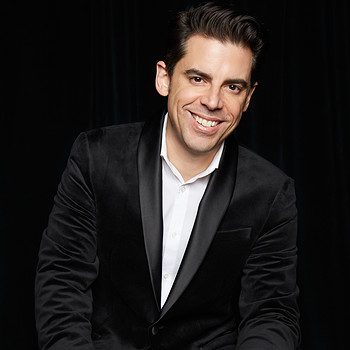Consider the unenviable task facing the Frank Sinatra tribute artist. Even filling out a set list must be a nightmare. Beginning to wrap things up Friday night at Jones Hall, Tony DeSare confessed “it’s possible we left out one or two hundred” of the astounding 1,500 or so songs Sinatra recorded during his 60-year career.
Featured artist and host of the Houston Symphony’s “Sinatra and Beyond” program, the New York-based DeSare then proceeded to cram five of the Chairman’s better-known numbers — “I’ve Got the World on a String,” “I’ve Got You Under My Skin,” “I Get a Kick Out of You,” “Summer Wind” and “Theme from ‘New York, New York’” — into about as many minutes.
But please don’t call that cheating. Sinatra himself, who died in 1998, was a medley master. Besides, four other selections, fully one-fourth of the two-hour show, came from outside of Apple Music’s “Frank Sinatra Essentials” list, itself 52 songs deep. Tossing in just enough touchstones to keep the audience from scratching their heads enabled DeSare and the orchestra’s Principal Pops Conductor, Steven Reineke, to spotlight equally worthy lesser- known tunes: Johnny Mercer’s sprightly “Something’s Gotta Give,” for example, or Irving Berlin’s ragtime-laced “I Love a Piano.”
Overall, the concert served as a reminder of not only how crucial a live orchestra was to Sinatra’s sound, but how shrewdly the arrangements (many by the great Nelson Riddle) were designed to accentuate and accommodate the peaks and valleys of his singular voice. In other words, a swinging rhythm section, coupled with silken strings bumping up against exclamation-point horns, goes a long, long way. The way the woodwinds seem to stir up the bittersweet memories of “It Was a Very Good Year” hasn’t lost any of its power, either.
As for DeSare, the way he avoided falling into the trap of becoming a Sinatra caricature was simple: he didn’t even try. His vocal range may not be as broad as Ol’ Blue Eyes’, but he can hold onto a note if he needs to. He’s only 44, which made it difficult to fully approach the world-weariness Sinatra invested into ballads such as “One for My Baby (and One More for the Road)” — he was actually close to DeSare’s age when he recorded the song in 1958, but somehow Frank sounds twice as old.
However, DeSare’s relative youth let him feed off the orchestra’s swell vibe on uptempo numbers like “Come Fly With Me” and “Luck Be a Lady,” his voice brimming with vintage swagger. Playing to his strengths also allowed him to place the focus squarely on the songs rather than conjuring constant side-by-side Sinatra comparisons, a trade-off one suspects DeSare would make any day of the week.
This seems like a natural time to discuss the “Beyond” portion of the program. For whatever reason, perhaps to demonstrate the scope of the Sinatra aesthetic, DeSare and Reineke eschewed easy choices like “Witchcraft” or “Strangers in the Night” in favor of a handful of non-Sinatra songs.
One of these, Ray Charles’ “Hallelujah, I Love Her So,” made a high-kicking horn showcase. The DeSare-penned ballad “How Will I Say I Love You,” meanwhile, allowed him to tell a funny story about swapping songwriting tips with Sir Paul McCartney after the ex-Beatle walked into a DeSare performance at New York’s Café Carlyle cabaret.
Another original, “New Orleans Tango,” was appropriately steamy, but the most interesting choice was probably the Bee Gees’ “How Deep Is Your Love,” with guitarist Ed Decker’s dusky seven-string acting as an aural lava lamp. (The other members of DeSare’s touring combo, upright bassist Dylan Shamat and wonderfully named drummer Michael Klopp, had their moments as well.)
Especially if they have no time for the New York Yankees, those under 50 (or at least 40) may struggle to understand just how pervasively Frank Sinatra once dominated pop culture. A good starting point would be Bob Dylan’s trilogy of 2015-17 albums — “Shadows in the Night,” “Fallen Angels,” and “Triplicate” — which, by stripping away much of that tiresome Rat Pack mythology, polished Sinatra’s reputation as a peerless interpreter of American popular song.
In his own way, so does DeSare, whose reverent but hardly cartoonish mannerisms this weekend helped explain how the Chairman can still cast a considerable shadow into the 21st century’s second decade. To wit, someone in the mezzanine was audibly weeping during “My Way.”
Chris Gray is a Houston-based writer.


 Back to List
Back to List